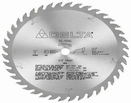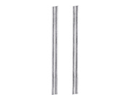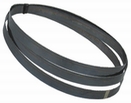


Before jumping into their first cuts and projects woodworkers and craftsmen have a lot to consider.. To help make this thinking process a little easier, here’s a few tips for keeping your saw blades in the most professional shape.
Ever wonder how many teeth makes the best saw blade, or which tooth-count delivers the smoothest, cleanest cuts? Well, you’re not alone and the answer comes simply once you understand how the saw-blade-tooth system works. In general, the more teeth your saw blade has, the smoother the cut. It’s as simple as that. This rule applies to whichever saw you’re using, whether it be a table saw, jig saw, scroll saw, etc. Saw blades with fewer teeth tend to slide more aggressively and produce a rougher cut. Essentially:
— The greater the tooth count – the smoother the cut.
Generally, it is recommended to have several blades available for each different saw. Having a variety of blades on hand makes different types of woodworking applications easier to perform. The easiest way to achieve the finest cuts is by staying true the specific application you’re performing. When cross-cutting, for example, always use a cross-cutting blade – when riping, a riping blade – when cutting metal, always use a metal cutting blade, and so forth. There are also saw blades with tooth patters specific for finishing applications; finishing and melamine blades are designed with a finer tooth pattern for the smoothest, most refined cuts. Remember to:
— Use saw blades that stay true to your cutting applications.
It is important keep your blades free of pitch and sap. These are residues that collect on the blade with every cut. To avoid problematic pitch or sap slop, and residual build-up – simply keep your saw blades clean. Wipe them down after every use. It’s beneficial to also clean your saw blades more thoroughly after every several uses. Periodically (and carefully) clean your blades with a diluted household cleaning solution. This should keep your blades shining and smooth, and ready to slice. Remember to:
— Keep your saw blades clean.
It is also important to keep your saw blades sharp. The sharpness of your blade determines (generally) the smoothness of your cut. When it becomes difficult to push your blade through your cutting materials, or if your blade is producing rough or choppy cuts – it’s about time to have it sharpened. It typically costs around $20 – $30 per blade for a professional sharpening. It’s also safer to keep your saw blades sharp; the less force exerted into the cutting process – the less likely a blade-related accident is to occur. Always:
— Keep your blades sharp.
To deviate from saw blades for a moment, I’ll address the misconception that planer blades are not reversible. Most of them absolutely are! Get twice the action from your planer blades by simply turning them over. Most planer blades have two sharp cutting edges at either end (i.e. on the top and bottom) – this is a reversible planer blade. It is generally beneficial to also have a spare blade on hand, that way if one breaks or requires sharpening, your prepared with a spare. Like saw blades, it is important to keep your planer blades sharp. Depending on the blade’s length, it typically runs about $15 – $20 to sharpen a planer blade. Rejoice:
— Most planer blades are reversible.
To achieve the most professional, precise cutting, simply keep your blades sharp, clean, and always use the proper blade and tooth count for each job. Following these simple steps ensures your blades are always in optimal cutting condition and your cuts are overwhelmingly accurate. Always also bear in mind that the most crucial rule when working with blades is to keep yourself safe. Be careful and happy crafting!













